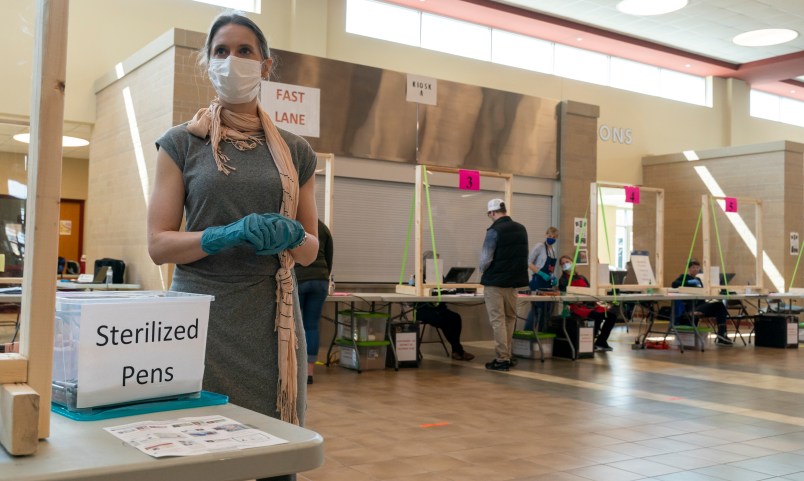Democrats got a banner victory in Wisconsin Monday evening as liberal Jill Karofsky dethroned incumbent State Supreme Court justice Daniel Kelly.
For liberals, the results were an exclamation mark on a week marred by Republican efforts to force in-person voting during the COVID-19 pandemic. At the same time, the conservative-majority on the U.S. Supreme Court curtailed absentee voting access, a move supported by GOP members of the Wisconsin Election Commission.
But for the Charles Franklin, director of the Marquette Law School poll, the Democrats’ path to victory is more evident in run-of-the-mill political trends than a last minute gush of outrage-fueled voting.
The Absentee Ballot Drama Fizzled Out
Much late-breaking controversy swirled around absentee ballots, about 200,000 of which were never returned to clerks after being sent out. Reports emerged of voters never receiving their ballots, and of ballots bearing ambiguous postmarks that put them at risk of being discounted based on the U.S. Supreme Court’s election-eve ruling.
Per Franklin, the ballots that didn’t get returned didn’t ultimately factor in much, except to the individuals who cast them. The percentage gap between ballots sent and those returned was pretty typical, though with a much higher total number of absentee ballots than Wisconsin usually handles, thanks to the pandemic.
“Out of 1.3 million requested, almost 1.1 million were received back,” he said. “That’s not especially out of line with what we normally see.” He added that it’s too early to know if the gap is due to the usual reasons — voters not filling out the ballots, issues with the mail — or to the chaos swirling around the last-minute legal fights.
Turnout In Supreme Court Races Was Already Growing
The high turnout was actually in keeping with trends for the state’s Supreme Court races.
“In 2019, just one year ago, the state Supreme Court race had 1.2 million votes cast, this year it’s a little above 1.5 million,” Franklin said of the increasingly partisan races. “The court had been on an upward trend absent presidential primaries, so sure, the presidential primary deserves some credit and maybe drew more Democrats to the polls, but that wasn’t the whole story.”
Trends For November? Maybe.
Now, with a new liberal justice set to take the bench, whittling the conservative majority down to 4-3, exuberant Democrats have their eyes set to November. The state that Hillary Clinton lost by 22,177 votes and that helped hand the election to President Donald Trump just saw a big Democratic victory despite Republicans’ best efforts to quash turnout — could that be a harbinger for the fall?
Franklin sees a few rays of hopes for the state’s liberal contingent.
He pointed to suburban counties ringing Milwaukee and Madison that have gone less and less red in statewide elections since at least 2012. “This is one more election showing that the suburbs in Wisconsin are far from purple, still quite Republican, but the margins that Republicans are carrying those suburbs by are shrinking,” he said. “That’s true across campaign, candidate and office, it’s not just Donald Trump.”
He also pointed to the Fox River Valley, counties including Green Bay around the river, that narrowly flipped to Karofsky last night. The cities in those areas are still blue and the surrounding areas red – but the balance has shifted from Republican rout to competitive horserace, he said.
But, Franklin urged caution: these are not normal times.
“I’m hesitant to read too much into it: surely how the epidemic plays out and economy fares are vastly more important than anything in yesterday’s vote,” he said. “Plague and unemployment may ultimately have a big role to play.”







1 million people voted in the 2016 Democratic presidential primary.
600,000 people voted for the progressive candidate in the 2019 SCOWI contest.
600,000 people voted for the conservative candidate in the 2019 SCOWI contest.
900,000 people voted in the 2020 Democratic primary.
856,000 people voted for the progressive candidate in the 2020 SCOWI contest.
692,000 people voted for the conservative candidate in the 2020 SCOWI contest.
630,000 people voted in the GOP’s 2020 primary.
Conclusion: It was the presidential primary that drove the increased voter participation that won this seat.
Both issues spell doom for Trump as people look for change.
Franklin is the guru, when it comes to Wisconsin voting data. And it is undoubtedly true that a lot will happen between now and November. However: Democrats winning by a ten-point margin, in races that historically go down to the wire and are won by the GOP like soccer matches are won by Germany, tells us that the Democratic base in Wisconsin is fired-up and above all organized, and that the GOP base is less so. This is a damn sight better than the opposite.
It’s also a big positive in the larger scheme of things. I’m not talking about November (when I think Biden will win). I’m thinking of the general truth that healthy and successful grassroots politics of the kind that drives special-election turnout is what is required to keep winning. And make no mistake, victory in November will only be the beginning of the work that lies ahead. We need to capture state legislatures and courts, draw fair maps, and pass a shitload of progressive laws. Moving forward can only happen with grassroots on fire–and that’s what we saw in Wisconsin.